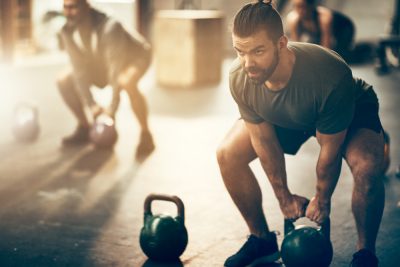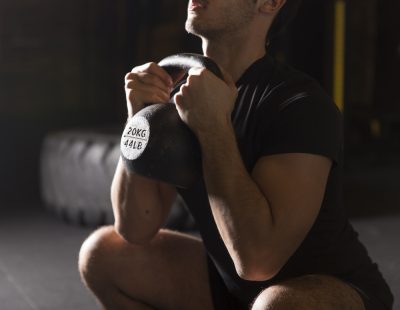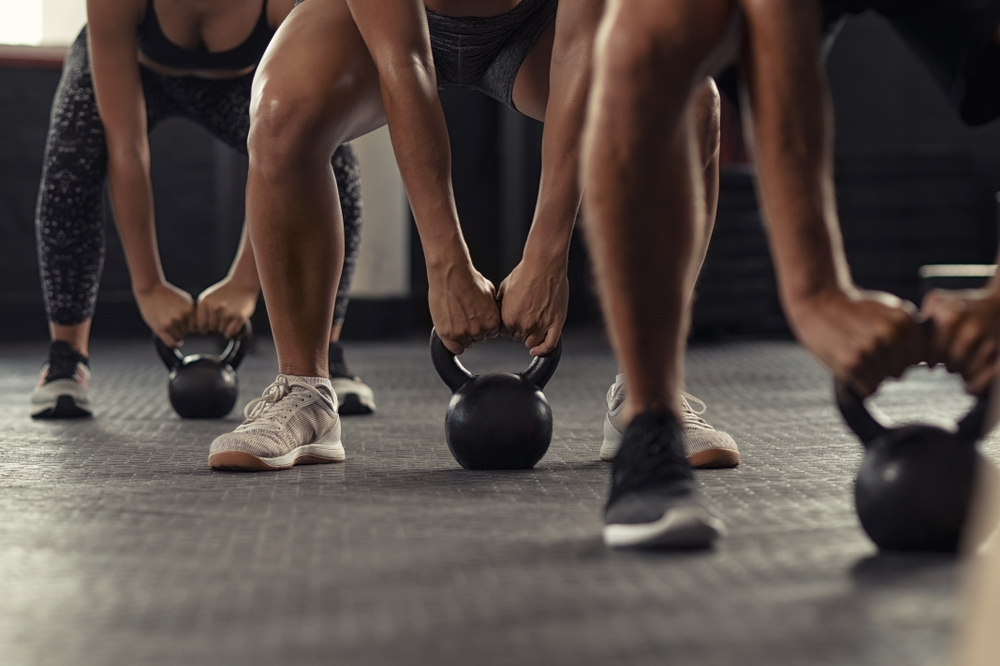If you are looking for an exercise that would help you develop cardiovascular fitness and build muscle (especially in the core, glutes, and legs), then the goblet squat is for you.
It is like an air squat but an amazing beginner-level progression because it can help beginners perfect their squat form as well as add resistance to the exercise.
The goblet squat is popular because it is specially designed to aid movement through a wide range of motion along with helping you avoid the primary mistakes people make such as letting your knees cave inside or leaning too far forward.
While it is an ideal exercise for beginners, it can also be incorporated by all kinds of exercises as it can be used as a way to progress to a weighed front squat with the use of a barbell or a robust warm-up while performing a lower body workout.
Just like the other squats, this one also focuses mostly on the muscles groups of your lower body.
How to perform the goblet squat
Getting ready for the goblet squat does not require too much as all you need is a large environment, and either a dumbbell or a kettle bell.
 To start, ensure your toes are angled slightly outward, and your feet are a bit wider than hip-distance apart.
To start, ensure your toes are angled slightly outward, and your feet are a bit wider than hip-distance apart.- Then you grab dumbbells and hold one in each hand at your chest; you should grip it as if you want to cup a goblet. Then you position the goblet at the center of your chest by bending your elbows.
- If you are just starting, you can get your sense of movement by using either a light dumbbell or no dumbbell at all. When you are used to the movement, you can then perform a full set with the use of a heavier weight.
- Look straight ahead and engage your core while ensuring that your eyes are facing straight ahead and your back is neutrally aligned while performing the exercise.
- Your hips should be pressed back as you start bending your knees to do the squat. While performing the downward phase, ensure that you inhale. Also, ensure that the dumbbell is kept close to your body the whole time.
- While pressing your hips back and lowering down, ensure that you keep your chest tall. Continue lowering your hips past the parallel point with your knees.
- Ensure that the dumbbell is adequately distributed across your feet and that when you squat, you don’t come up on your toes.
- On getting to the lowest point of the squat, check to make sure you positioned your elbows on the inside of either knee. This is to make sure that your knees are in line with your toes before moving into a deep squatting position.
- Then, revert to the starting position by pressing through your heels and reversing the motion. When rising, ensure that you exhale. Also, to fully engage your glutes, you have to press your hips forward at the top of the squat.
- When you have performed a set, rack the dumbbell with care as it is not advisable to drop the weight from a height. You can perform sets as many times as you wish.
Common mistakes when performing the goblet squat
It is possible to make mistakes while performing the goblet squat even though it is a simple exercise to execute.
These are the most common mistakes you should avoid making:
Knees caving inward while squatting
The goblet squat has been known to be effective when it comes to correcting a very common squat problem which is known as the caving inward of the knees or knee valgus.
You train yourself to keep your knees in line with your toes by trying to get your elbows to make contact with the inside of your knees when you get to the bottom of the squat.
This is like a reminder that tells you to check again for this problem when you have reached the bottom of the squat, before reverting to the starting point. It is a perfect way to correct the problem because this is the point where people usually experience caving inward of the knees.
When lowering into a squat, ensure that your knee caps are in line with your second toe. If you feel like your knees are angled slightly inward, you can pull them outward a bit by engaging your hips and glutes.
Rising on your toes
The mistake of rising on your toes when lowering into the squat is mostly caused by other form problems like leaning forward when squatting or holding the weight too far from your body.
This is more common in the goblet squat since you hold the dumbbell in front of your body while performing it.
You tend to throw yourself off the balance if you put weight on your toes, which will also prevent you from increasing the resistance of this exercise as well as compromising the integrity of your knees.
While lowering into the squat, ensure that your torso and chest remain tall and upright. As you squat, you have to be able to wiggle your toes a bit.
This acts as a reminder that tells you to keep your center of gravity more centered and farther back over your heels rather than forward on your feet.
Leaning forward from the waist
A common mistake people make while performing this squat is tipping or leaning forward when carrying out the movement.
This would affect the neutral alignment of the spine and make you more susceptible to rising on your toes while lowering into the squat or losing your balance.
If you want to avoid leaning forward while doing this exercise, ensure that you mount a mirror so that you can keep checking your sides.
Roll your shoulders back and draw your shoulder blades toward your spine before you begin the squat. Then you engage your core muscles and watch yourself in the mirror as you start pressing your hips back to begin the movement.
As time goes on, you can work on your range of motion as you may not be able to reach the deepest point of the squat as a beginner.
What you should focus on is correcting the error of leaning forward from your waist as this would help you see better improvements in range of motion, resistance level, and form as time goes on.
A great tip is to look up at a slight angle if you feel like you are leaning forward from the waist or if you notice that your shoulders or chest are rounding or collapsing forward.
Holding the weight too far from your body
This is probably the most common mistake made when performing a goblet squat. Ensure that the dumbbell is racked close to your body at your chest at all times.
What you have to do is ensure that you fully bend your elbows and that the dumbbell is close to you so that your biceps don’t feel strained trying to hold it in place.
When the dumbbell is held too far away from the body, you will find yourself engaging your forearms, biceps, and the anterior part of your shoulders more to avoid your shoulders and chest leaning forward as you lower into the squat, which will eventually offset your balance.
This would limit how much weight you can utilize when performing the squat as well as make it difficult for you to maintain proper form.
Your legs are capable of carrying and supporting a significant level of resistance than your forearms and biceps can, which is why you should ensure that your arms are not doing a lot of work to hold the dumbbell in place. This would also guarantee that you progress faster.
Benefits of the goblet squat
Alignment
 This exercise aims at getting your elbows to touch the insides of your knees when you get to the deepest point of the squat. This is why the goblet squat helps with the alignment of your knees with your toes.
This exercise aims at getting your elbows to touch the insides of your knees when you get to the deepest point of the squat. This is why the goblet squat helps with the alignment of your knees with your toes.
As stated above, knee valgus is a common problem where your knees get angled in slightly as you lower into the squat. This misalignment is most pronounced when you get to the bottom of the squat.
If your knees are angled slightly inward, trying to get your elbows to touch the inside of your keeps will help keep your knees in line with your toes.
Squat form
One of the major benefits that come with performing the goblet squats is that it is effective when it comes to improving squat form.
While the general squat form is common among most exercisers, it is still surprising that people make mistakes that often lead to injuries, especially of the knees or low back.
Because the weight is being held in front of your body at your chest, you will be more focused on the importance of keeping your core engaged and your torso tall as you lower into the squat.
A lot of people start leaning their chest toward the ground, tipping forward from their hips, and compromising the neutral position of their back as they lower into the squat.








COMMENTS